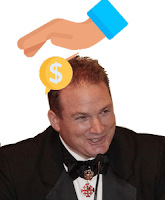The palace was built in the 15th-century. The Chigi family acquired it in 1661 and in 1664 began for several years to rebuild it in baroque style. This was initiated by Fabio Cardinal Chigi, who a year later in 1665 was elected Pope Alexander VII. He died in 1667 before the restructuring was complete. His preferred architect was Bernini who worked on the project with Carlo Fontana.
There are two chapels in the palace. The main chapel, depicted here, opens into the main hall, where meals were taken and gatherings and parties were held. The chapel design is by Bernini and Cortona and the interior dates from the 17th-century. Over the years many Chigi family weddings have been held here.
The main altar has a painting by Raffaelo Vanni, representing St. Thomas Villanova and St. Francis de Sales with Our Lady. This beautiful work was commissioned in celebration of the two saints who were canonized by Pope Alexander VII Chigi in 1658 and 1665.
The walls are covered with precious wall hangings, golden in color, in flocked leather with minced velvet glued to the surface. The artist was Agostino Nespola "coramaro" who created these in about 1673. This is a rare example of wall coverings from that period that have survived intact.
All of the furniture with the Chigi-Borghese crest date from about 1663. They were made by Antonio Chicari, a close collaborator of Bernini.
On the altar is a relic of the true cross along with other relics owned by the family, including some Agnus Dei wax relics kept in golden baroque reliquaries.
The most celebrated image in the chapel is by Bernini himself. It is located on the left wall, a renowned painting representing St. Joseph with the Child Jesus. It is signed by the artist and dated 1663. The image is surprisingly simple and fresh, almost like a light sketch.
In 1988 Prince Agostino Chigi Albani della Rovere (1929-2002) sold to the Commune the entire palace and attached park, with its Roman spoglia. The family is today represented by Prince Mario Chigi Albani della Rovere (born in 1929) who lives in the Castello Chigi at Castelfusano near Ostia. His son, Duke Flavio (born in 1975), is his heir. Unfortunately, as with the other Roman nobility, the family line has suffered due to the contraceptive culture and the failure to pass on the Faith intact to the next generation.
Below are a few images from another chapel in the palace dating from the same period, with a painting of St. Francis de Sales.

























